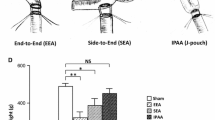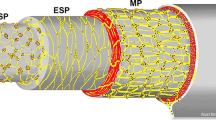Abstract
Introduction
After successful experimental autologic-allotopic ileum mucosa transplantation, we investigated the remodeling of the transplanted submucous and mucous plexus, which is essential for the motility of the created colon coat-ileum mucosa complex.
Method
In 8 beagles we transplanted ileum mucosa in a demucosed vascularized transverse colon segment, which was reanastomosed with the small bowel immediately after transplantation. Four weeks later the animals were sacrificed and histology specimens taken from the anastomosis site of the colon coat-ileum mucosa complex, allowed comparison between transplanted and normal mucosa in the same section. After fixation in 4% formaldehyde and PBS the samples were embedded in paraffin and 7 µm sections were prepared. The distribution of nerve fibers and submucous ganglia were examined in dewaxed sections, using antisera against protein gene product (PGP9.5), a general neuronal marker.
Results
The submucosal ganglia were prominent in all samples but they were smaller and the submucous nerve cells within the ganglia were less numerous compared to the controls. The innervation of the transplanted ileum mucosa was reduced as the number of nerve fibers in the mucosal villi was decreased. Besides these neuromorphologic changes the transplanted mucosa showed a slightly higher rate of shortened villi compared to normal ileum mucosa.
Conclusions
After ileum mucosa transplantation the submucosal ganglia are smaller and less numerous. Furthermore there is a considerable loss of nerve fibers in the mucosal layer. Additionally a loss of microvilli in the transplanted ileum mucosa was found. Whether these findings represent a state of remodeling or a slow atrophy of the enteric nervous system in the transplanted areas is currently under investigation.






Similar content being viewed by others
References
Altmann DP, Ellison EH (1965) Massive intestinal resection: inadequacies of the recirculating loop. Surg Forum 16:365–367
Bianchi A (1980) Intestinal loop lengthening—a technique for increasing small intestinal length. J Pediatr Surg 5:145–151
Bianchi A (1999) Experience with longitudinal intestinal lengthening and tailoring. Eur J Pediatr Surg 9:256–259
Chabert J, Pellissier S, Eribon O, Roche M (2000) Reversed bowel segments for the treatment of short bowel syndrome: assessment of the minimal length in correlation with electromyographic pattern in the rat. Neurogastroenterol Motil 12:53–63
Chahine AA, Ricketts RR (1998) A modification of the Bianchi intestinal lengthening procedure with a single anastomosis. J Pediatr Surg 33:1292–1293
Chen MK, Badylak SF (2001) Small bowel tissue engineering using small intestinal submucosa as a scaffold. J Surg Res 99:352–358
Coran AG, Spivak D, Teitelbaum DH (1999) An analysis of the morbidity and mortality of short-bowel syndrome in the pediatric age group. Eur J Pediatr Surg 9:228–230
Freud E, Eshet R (2001) Insights from animal models for growing intestinal neomucosa with serosal patching—a still untapped technique for the treatment of short bowel syndrome. Lab Anim 35:180–187
Holden C (2001) Review of home paediatric parenteral nutrition in the UK. Br J Nurs 10:782–788
Hori Y, Nakamura T, Kimura D, Kaino K, Kurokawa Y, Satomi S, Shimizu Y (2002) Experimental study on tissue engineering of the small intestine by mesenchymal stem cell seeding. J Surg Res 102:156–160
Kaihara S, Kim SS, Kim BS, Mooney D, Tanaka K, Vacanti JP (2000) Long-term follow-up of tissue engineered intestine after anastomosis to native small bowel. Transplantation 69:1927–1932
Kato T, Ruiz P, Thompson JF et al. (2002) Intestinal and multivisceral transplantation. World J Surg 26:226–237
Kaufman SS, Atkinson JB, Bianchi A et al. (2001) Indications for pediatric intestinal transplantation: a position paper of the American Society of Transplantation. Pediatr Transplant 5:80–87
Kimura K, Soper RT (1993) A new bowel elongation technique for the short-bowel syndrome using the isolated bowel segment Iowa models. J Pediatr Surg 28:792–794
Kocoshis S (2001) Evolving concepts and improving prospects for neonates with short bowel syndrome. J Pediatr 139:5–7
Nucci AM, Barksdale EM Jr, Beserock N, Yaworski JA, Iurlano K, Kosmach-Park B, Reyes J (2002) Long-term nutritional outcome after pediatric intestinal transplantation. J Pediatr Surg 37:460–463
O’Brien DP, Lindsey AN, Frederick SH, Brad WW (2001) Intestinal adaptation: structure, function, and regulation. Semin Pediatr Surg 10:56–64
Parnigotto PP, Marzaro M, Artusi T, Perrino G, Conconi MT (2000) Short bowel syndrome: experimental approach to increase intestinal surface in rats by gastric homologous acellular matrix. J Pediatr Surg 35:1304–1308
Platell CF, Coster J, McCauley RD, Hall JC (2002) The management of patients with short bowel syndrome. World J Gastroenterol (China) 8:13–20
Reyes J (2001) Intestinal transplantation for children with short bowel syndrome. Semin Pediatr Surg 10:99–104
Sigalet DL (2001) Short bowel syndrome in infants and children: an overview. Semin Pediatr Surg 10:49–55
Sundaram A, Koutkia P, Apovian CM (2002) Nutritional management of short bowel syndrome in adults. J Clin Gastroenterol 34:207–220
Taha MO, Ribeiro MA Jr, Oliveira Gomes P de et al. (1999) Evaluation of the longitudinal musculature of segments of the distal colon interposed following extended jejunum-ileum resection. Microsurgery 19:306–310
Teitelbaum DH, Thomas T (2001) Parenteral nutrition-associated cholestasis. Semin Pediatr Surg 10:72–80
Thompson JS, Barent B (1999) Effects of intestinal resection on enterocyte apoptosis. J Gastrointest Surg 3:672–677
Willis S, Klosterhalfen B, Titkova S et al. (2000) Effect of artificial valves on intestinal adaptation in the short-bowel syndrome: an integrated study on morphological and functional changes in rats. Eur Surg Res 32:111–119
Zachariou Z, Daum R, Beiler HA, Gorgas K (1998) Autogenic allotopic small bowel mucosa transplantation. A new perspective for treatment of small bowel syndrome. Eur J Pediatr Surg 8:230–233
Author information
Authors and Affiliations
Corresponding author
Rights and permissions
About this article
Cite this article
Beiler, H.A., Schäfer, KH., Hagl, C. et al. Histologic changes in neuronal innervation of the ileum mucosa after autologic-allotopic ileum mucosa transplantation. Ped Surgery Int 20, 96–100 (2004). https://doi.org/10.1007/s00383-003-1095-1
Accepted:
Published:
Issue Date:
DOI: https://doi.org/10.1007/s00383-003-1095-1




